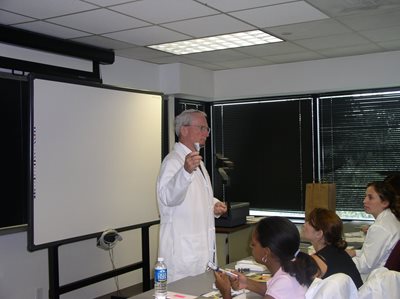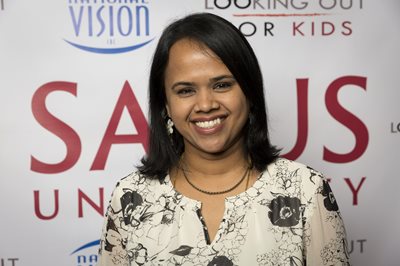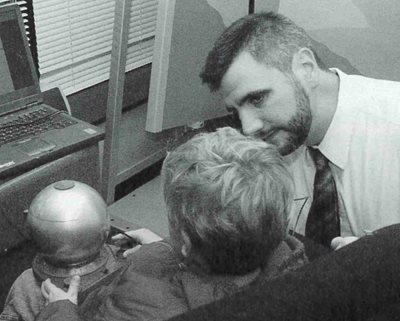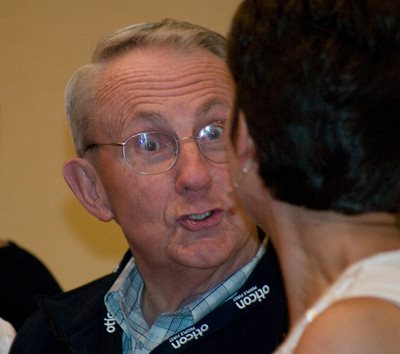(This is the second of a two-part story on the history of the Osborne College celebrates its 20th anniversary.)
Radhika Aravamudhan, PhD, thought it was odd. Even though she and Dr. George Osborne were quite fond of each other — he had hired her in 2004 and held the job for a year while she completed a post-doc — they argued over just about everything.
And on this day, they had one of their arguments, this time about a clinical research course that she thought the audiology program needed and he didn’t.
 “Our students have to be good consumers of research, even at the master’s level,” she recalled making her argument to him. “Audiologists were required to understand research and we didn’t have any of that in the curriculum. So we went back and forth on it and his answer to me was, ‘go home and sleep on it.’”
“Our students have to be good consumers of research, even at the master’s level,” she recalled making her argument to him. “Audiologists were required to understand research and we didn’t have any of that in the curriculum. So we went back and forth on it and his answer to me was, ‘go home and sleep on it.’”
Later that evening, in 2007, she wrote Dr. Osborne an email detailing her vision on how the course would evolve, and then went to bed.
By the time she got to campus the next morning, there was no response from Dr. Osborne. It got to be 9 a.m., then 10 a.m. and still no response from Dr. Osborne. In fact, he was usually the first one in the office and he hadn’t shown up yet.
“He usually replied to emails. It didn’t matter what time of the day it was, he usually replied within five minutes or less,” said Dr. Aravamudhan. “Even before I would shut my phone down or look at my computer again, he would be just acknowledging that he got the email and that we would talk about this tomorrow. He was not the kind of guy who would just sit on emails, he would reply immediately.”
 By mid-morning, Dr. Aravamudhan approached Paula Kane, now retired but then an executive assistant in the audiology department.
By mid-morning, Dr. Aravamudhan approached Paula Kane, now retired but then an executive assistant in the audiology department.
“Is George OK?” asked Dr. Aravamudhan.
“Why do you ask?” answered Kane.
“Well, this is so bizarre. I sent him an email last night around 10 p.m. and haven’t gotten a thing back from him yet,” said Dr. Aravamudhan.
“Maybe he just hasn’t gotten it. He’s not here yet,” said Kane.
The reason would be all too painfully obvious later that afternoon: Dr. Osborne had died.
According to Dr. Thomas Lewis, OD ’70, PhD, FAAO, president of the Pennsylvania College of Optometry and later Salus University from 1989 to 2013 and now president emeritus, Dr. Osborne built and flew his own airplanes. Sometimes after work he would drop by the airplane hangar to make sure everything was in order with his plane if he planned to take it out the next day.
That’s what had happened that evening. Dr. Osborne was seeing a friend the next day who was coming in for the weekend and he wanted to make sure the plane was in order because the two were going to take it up the next day. When it got to be around 10 p.m. that evening and Dr. Osborne hadn’t returned home, his wife had gone down to the hangar and discovered him near the plane. He had apparently died from asphyxiation.
“I was traveling at the time and I got a call from Lisa Lonie (assistant to the president) and she told me the news,” said Dr. Lewis. “I was floored.”
Dr. Osborne’s death also gave a jolt to the audiology program, which was essentially still in its infancy.
“It was a dramatic loss. George was probably one of the 10 best-known audiologists in the United States, and one of the most respected,” said Dr. Lewis. “So it wasn’t just that we lost someone, the profession on a national level lost someone who was very important.”
The audiology department consisted of a young faculty at the time of Dr. Osborne’s death. Dr. Aravamudhan was only two years out of school, and she and Dr. Danielle “Yell” Inverso were the only two full-time faculty members. Tricia Dabrowski, AuD ‘07 was the clinic director and Debbie Bussaco, PhD, was the program director.
“We didn’t know what to do,” said Dr. Aravamudhan. “We knew the program was going to be here and we were going to do what we had to do to get our students through the program. But how could this happen?”
 After several changes in administration of the college, Dr. Aravamudhan stepped in as the interim director for the on-campus program. George Lindley, PhD, AuD ’03, took over the management of the AuD online program.
After several changes in administration of the college, Dr. Aravamudhan stepped in as the interim director for the on-campus program. George Lindley, PhD, AuD ’03, took over the management of the AuD online program.
“People called from all over to ask what we needed and how they could help. Do you need a clinical site, I’ll take a student. Do you need this course taught, I’ll come in to teach,” said Dr. Aravamudhan. “Two people, Gail Gudmundson, AuD ’02, and Tomi Browne, AuD ’04, they flew here. I don’t know what they thought they could do, but just having them around made us feel that we could ask them to help. They were experienced people. Whatever we needed, they were there. And it wasn’t just them. Everybody, the emails we got, people followed through, they didn’t just say it. And that is the kind of support that we still enjoy.”
Dr. Lindley said that Dr. Osborne’s death did force some issues on the College.
“His death certainly didn’t have a positive effect on the program. But I do think it did force us — because he would do so much — to say hey, we’ve got to spread out the responsibilities. The first task was to get it up and running and show that it was a viable entity, but we had to grow and get organized about it,” said Dr. Lindley.
 After almost exactly two years of making it work without Dr. Osborne, the College hired its next dean. Victor Bray, PhD, FNAP, was from outside of academia — he had been the vice president and chief audiology officer of a hearing aid company. During his interview, he had asked Dr. Anthony Di Stefano, OD ’73, MEd, MPH, FAAO, why the College wasn’t looking at hiring somebody from another audiology program who was an experienced academic.
After almost exactly two years of making it work without Dr. Osborne, the College hired its next dean. Victor Bray, PhD, FNAP, was from outside of academia — he had been the vice president and chief audiology officer of a hearing aid company. During his interview, he had asked Dr. Anthony Di Stefano, OD ’73, MEd, MPH, FAAO, why the College wasn’t looking at hiring somebody from another audiology program who was an experienced academic.
“And he was very clear. He said, ‘The objective of this audiology program is not to be like all the other programs. It is to implement a new educational model as George Osborne envisioned,’” recalled Dr. Bray. “This was set up — I realized when I was running it — as a grand experiment to see if a professional school model would work for audiology. The reason healthcare professions use professional schools is that you have critical mass of students, tuition dollars, faculty, facilities, resources — you bring all of those together to a large program where you can have a high level of training with lots of resources available. That’s not the model that’s used in audiology, but that was the assignment here.”
Dr. Bray set out to accomplish just that. At the time, there were two parts to the program. One part was phasing down and one part was ramping up. Audiology had already made a decision to transition from a master’s level profession to a doctoral level profession.
And there became two paths to make that happen: one was to provide an online opportunity for people who had master’s level degrees and significant clinical experience, to upgrade their academic knowledge and clinical skills knowledge. For those people, there were a few programs around the country that put together a distance education — called a “bridge” program — so the person could bridge from the master’s degree to the doctoral degree.
“The intent of the bridge program, as Dr. Osborne saw it, was that it would open, it would run, and it would close. And people who had master’s degrees and wanted to get the advanced education needed to do that. So the program was open for roughly a decade,” said Dr. Bray. “And when I came here in 2009, the program was scheduled to close I think in 2010. And I did close it. That was Dr. Osborne’s intent.”
Subsequent to that, Dr. Girija Sundar, PhD, was hired as the director of distance education program to reopen the bridge program that focused on the international audiologist. Called the second-generation DE bridge program, opened around 2011 and is still successfully running today. This program has given Osborne College of Audiology a global footprint.
 “The importance of the AuD online program is in the U.S. the transition was made to go to the doctoral degree and beyond a certain point, anybody getting an original license had to have a doctoral degree. The people who went through our bridge program could continue to practice, they were able to earn their AuD degree,” said Dr. Bray.
“The importance of the AuD online program is in the U.S. the transition was made to go to the doctoral degree and beyond a certain point, anybody getting an original license had to have a doctoral degree. The people who went through our bridge program could continue to practice, they were able to earn their AuD degree,” said Dr. Bray.
Even though the University closed the first generation AuD bridge program, it continued to receive requests from the international audiologists who were interested in earning their AuD degree. The way Dr. Bray threaded that needle was to follow Dr. Osborne’s plan and close it, but in parallel open up the second generation program that was focused on international and did not prohibit American audiologists from enrolling.
In the AuD on-campus program, “We had gotten the class sizes up to more than 30, we’d gotten the student size up more than 100 students, we had gotten higher-level faculty and we continued to use infrastructure that’s here,” he said. “The first five-year period — 2009 to 2014 — we did what was necessary to get the on-campus program up and running. We got the faculty hired, got the clinical sites together, build a robust program. The second generation distance education program — with its focus on international students — got up and running. We continued to produce AuDs around the world.”
Although filling the big shoes of Dr. Osborne became a team effort in the years since his death, the George S. Osborne College of Audiology (OCA) — named so after its founding dean in 2008 at the same time PCO established Salus University — has continued to lead the way in the audiology profession.
Dr. Lewis and Dr. Di Stefano have retired. Dr. Lindley still teaches at the College, and serves as the interim assistant dean. Dr. Bray, who eventually stepped down as the dean of the college, continues to serve as a faculty in the college. Dr. Aravamudhan, who served as as interim dean from 2015-2018 and then was selected as the dean of the College in 2018, is an associate professor and still teaches at the College.
“I will say I feel like I knew in the moment that we were doing something special. It’s not something I realized just recently. I kind of felt it as we were doing it. I remember thinking this was either going to be three or four years of my life trying something that flopped that we at least tried, or it might be something that will live on and evolve and one of the things I’ll be most proud of,” said Dr. Lindley. “It took us longer than we planned, but eventually we got it to where we wanted it to be in terms of being the largest AuD program. And it’s not the pure professional model that we may have thought it was going to be. It’s more of a hybrid of taking the things that were working in traditional audiology education and then adding in this new element of the more professional aspect and merging that together.”
“As we continue to build Dr. Osborne’s legacy and lead in audiology education, we have developed a new three-year track for the AuD on-campus program in response to increasing student return on investment,” said Dr. Aravamudhan. “It is the same four-year program, offered in a quarter system, giving select students an opportunity to complete the program in three years. We at OCA continue to grow and lead in audiology education and innovate.”
Dr. Aravamudhan believes the success of the College and the programs within the College is primarily because of the dedicated faculty, staff and alumni, both on-campus and in distance education.
“We continue to grow and lead in Audiology education not only within the U.S. but across the world,” she said. “The future for OCA is strong and we look forward to updating everyone with success stories of our programs, our people and our students.”